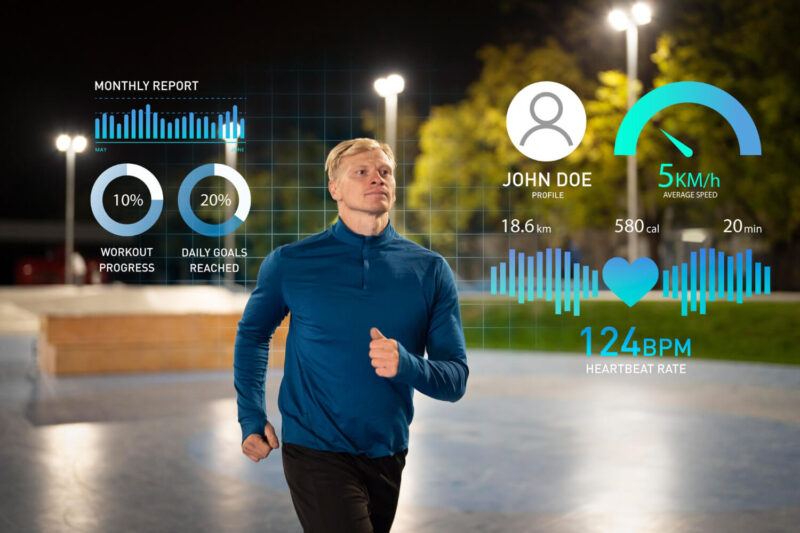It’s not surprising that AI has refined the sports industry to a new level. It is changing how sports teams practice, play games and communicate with their fans.
As AI becomes more involved in sports activities, the clash between coaches’ intuition and new technologies starts to happen. On the one hand, machine learning in sports strategies is churning through mountains of data, offering insights and predictions that were once unimaginable. On the other hand, veteran coaches with years of experience and a sixth sense for the game still command respect.
A crucial debate is unfolding: Should we trust ML’s cold calculations solely, or should we value human intuition’s gut feeling? It’s promising that AI in sports will not replace experienced coaches but rather collaborate to offer more insights, aiming to make their team the best in the sports industry.
This blog post aims to guide you through the impact of sports analytics and machine learning. It will demonstrate how these technologies strengthen coaches’ approaches and help create winning strategies.
The Rise of Machine Learning in Sports
Machine learning (ML) has become a useful method in sports. It all started with a simple shift: having technology that analyzes basic store stats like points. However, as sports activities begin to emerge, a new approach is required to develop a game-winning strategy that is not only based on experience but also helps coaches get insight into trends.
However, the rise of AI in sports decision-making has led to the adoption of machine learning in sports. This technology assists coaches in processing massive datasets and identifying complex patterns and trends invisible to the human eye, leading to several key benefits.
1. Analyzing Player Performance
ML can dissect a player’s every move, from shot selection to movement patterns, providing a nuanced understanding of strengths and weaknesses. This helps coaches tailor training programs and identify potential breakout stars.
2. Predicting Outcomes
By analyzing historical data and player performance, ML models can predict the probability of certain events happening during a game. Imagine knowing the likelihood of a specific player making a three-pointer or a team scoring in a particular zone. This allows teams to develop targeted strategies.
3. Strategic Planning
ML goes beyond mere prediction. It can analyze opponent tendencies and suggest defensive adjustments or offensive plays with the highest chance of success. This empowers coaches to make data-driven decisions and gain a competitive edge.
The Value of Human Intuition
The use of machine learning in sports strategies has transformed the game. It opened up possibilities that weren’t possible by relying on coaches’ experience. We all have our flaws and areas we can improve in sports, and these technologies are helping us target those weaknesses more effectively. In the end, they’re making us better players overall.
But that doesn’t mean human intuition in sports holds no value. It will be the most important attribute that team players have and brings undeniable power to sports strategy. History is filled with examples of successful strategies born from intuition. Michael Jordan’s legendary 1997 “flu game” performance, in which he defied illness to lead his team to victory, was fueled partly by his competitive spirit and a coach’s trust in his star player.
Similarly, the “Philly Special,” a trick play that helped the Philadelphia Eagles win the 2018 Super Bowl, was a last-minute audible call by the coach based on a gut feeling about the defense’s positioning. Some other benefits human intuition brings in Artificial Intelligence in sports are mentioned below.
1. Understanding Player Psychology
Numbers can’t capture the complex web of emotions, motivations, and rivalries influencing athletes. A seasoned coach can read a player’s body language, sense their confidence level, and make adjustments based on intangibles that escape ML algorithms.
2. Making Split-Second Decisions
The pace of a game demands real-time decision-making. In the heat of the moment, a coach’s intuition can be the difference between calling a perfect timeout to disrupt an opponent’s momentum or sticking with a strategy that feels right, even if the data suggests otherwise.
Machine Learning vs. Human Intuition in Sports Strategy
Having witnessed the advantages of machine learning in sports strategies and human intuition, it’s crucial to examine their distinct values in the sports industry.
|
Features |
Machine Learning (ML) |
Human Intuition |
|
Strengths |
Processes massive data, identifies complex patterns, predicts outcomes, and provides data-driven insights. |
Reads player psychology, makes split-second decisions, adapts to unforeseen situations, and taps into human motivations. |
|
Weaknesses |
Ml lacks an understanding of human emotions and psychology, struggles with real-time decision-making, and cannot account for unforeseen circumstances. |
Can be biased by personal experience, susceptible to emotional swings, may miss insights hidden within data |
|
Data Analysis |
ML demonstrates excellence due to its ability to process vast amounts of data, while human intuition is limited in this aspect. |
Human intuition excels in real-time decision-making, while ML performs poorly in this area. |
|
Player Psychology |
ML has no inherent understanding, |
human intuition possesses a deep understanding due to the nuanced observations and interactions with players over time. |
Finding the Balance: Integrating ML with Human Expertise
Coaches are the experts when it comes to training players and crafting winning strategies. Their own experiences facing challenges on the field give them invaluable insights to guide their teams. However, in today’s highly competitive sports landscape, achieving success requires blending technology and sports performance metrics into training plans and game strategies to secure victories.
Therefore, to have the full power of sports strategy lies in achieving a harmonious integration between machine learning (ML) and human expertise. Here’s how to make it work.
1. Combining ML and Human Judgment
Both sides must have clearly defined roles. AI in sports decision-making provides data and insights, whereas human experts interpret them within the context of the game and player dynamics. Open communication between analysts and coaches is crucial for effective strategy development.
In addition, Blindly trusting ML is a recipe for disaster. Humans must oversee the process, ensuring data quality and understanding the “why” behind ML recommendations. Techniques like explainable AI might help make the models’ reasoning more transparent.
No need to automate everything. A room for human intuition is required to shine in areas like player motivation, team chemistry, and adapting to unexpected situations.
2. Training & Decision-Making with ML
First, it is clear that data-driven sports strategies are a powerful tool for augmenting, but they can never replace human decision-making. AI in sports is needed to ze vast amounts of player data, helping identify hidden gems and assess potential draft picks with a level of detail previously impossible. This will only empower coaches and scouts to make informed decisions.
Further, ML also helps to personalize training for each player, highlighting their strengths and weaknesses. This allows coaches to create more targeted drills and training plans. By fostering a collaborative environment where ML and human expertise work together, teams can gain a deeper understanding of the game, make smarter decisions, and create a winning strategy.
Case Studies – ML and Intuition-Shaping Sports History
Let’s explore some real-life examples to better comprehend how AI in sports collaborates with coaches’ intuition to achieve successful game wins.
1. The Houston Rockets and the “Moneyball” Revolution (ML)
Under General Manager Daryl Morey’s leadership, the Houston Rockets introduced a new way of thinking in basketball called “Moneyball.” They relied heavily on advanced statistics to shape their team, focusing on areas like three-point shooting and free throw attempts rather than traditional metrics like rebounds.
Although this approach initially raised doubts, the Rockets experienced consistent success, even reaching the NBA Finals twice. Their story demonstrates how data-driven strategies can lead to remarkable achievements in sports.
2. The “Minneapolis Miracle” and the Power of Gut Feeling (Intuition)
In 2018, during an intense playoff matchup between the Minnesota Vikings and the New Orleans Saints, there was a memorable moment. With just seconds left on the clock and the Vikings trailing by a field goal, everyone expected a conventional play.
But then, Vikings Head Coach Mike Zimmer surprised everyone with a gutsy decision. Instead of playing it safe, he called for a daring Hail Mary pass. It was a bold move, driven by intuition and a belief in a specific matchup advantage. And it paid off – resulting in a game-winning touchdown. This unforgettable play, dubbed the “Minneapolis Miracle,” will forever be etched in NFL history.
3. The Oakland Athletics and Billy Beane’s “Moneyball” Magic (Combination)
Michael Lewis’s book “Moneyball” tells the story of how the Oakland Athletics, led by General Manager Billy Beane, achieved success despite financial limitations. Unable to afford top-tier players like other wealthy teams, Beane turned to sabermetrics, a method of baseball analytics.
By analyzing statistical data, Beane identified undervalued players overlooked by traditional scouting methods. This innovative “Moneyball” strategy, blending intuition with data analysis, enabled the Athletics to assemble a competitive team despite budget constraints. Their story demonstrates the power of combining both approaches for success in sports.
The Future of Sports Strategies
According to data, the sports AI market was valued at $2.1 billion in 2022. It’s projected to grow steadily at a rate of 30.10% from 2023 to 2030, reaching an estimated value of $19.2 billion by 2030. Sports is an ever-changing industry, and there are still many areas that need improvement.
Moreover, The future of sports strategy promises an even more intricate dance between machine learning (ML) and human intuition. Here’s a glimpse of what’s to come.
1. AI-powered Scouting & Coaching
Imagine AI assistants that can scout players in real time, suggesting potential draft picks or on-the-fly adjustments during games. However, human coaches will remain key to interpreting this data and making the final decisions.
2. Advanced Analytics
Expect even more sophisticated ML algorithms that can analyze player performance, fan sentiment, team chemistry, and external factors like weather conditions.
3. Wearable Tech & Biometric Data
The rise of wearable technology will provide a constant stream of biometric data on players. ML will analyze this data to assess fatigue levels, injury risks, and emotional states, further optimizing training and in-game decisions.
Conclusion
The future belongs to teams that can master this co-evolution. Sports organizations will be transformed and create a more captivating experience for fans by embracing ML and human intuition. However, the human element remains irreplaceable. Intuition allows coaches to read player psychology, make split-second decisions, and adapt to the game’s unpredictable nature.
The key to success lies not in choosing between these two forces but in achieving a harmonious balance. By effectively integrating ML insights with human judgment, teams can gain a deeper understanding of the game, make smarter decisions, and create a winning edge.
Frequently Asked Questions (FAQs)
How Does Machine Learning Complement Human Intuition in Sports Strategies?
Machine learning in sports strategies generates insight and new trends in the data it is trained on, but making competitive plans using these metrics requires an experienced coach. In this way, machine learning complements human intuition in sports.
What Are Some Successful Examples of ML and Human Intuition Working Together in Sports?
The most prominent example is the Minneapolis Miracle, where a coach’s gut feeling led to a game-winning Hail Mary pass, a play that was not entirely dependent on ML analytics.
What Are the Limitations of Relying Solely on Machine Learning in Sports Decision-Making?
Machine learning cannot pinpoint areas where individuals need to improve, and it cannot inspire players to give their best in sports. Coaches, on the other hand, are experts at getting players to align with team goals and motivating them to perform at their highest level.
How Can Coaches and Teams Integrate Machine Learning Insights Into Their Strategic Planning?
Coaches and teams integrate machine learning insights into their strategic planning by collecting data, analyzing it with algorithms, and applying findings to refine game plans and player strategies for competitive advantage.
What Future Advancements Are Anticipated in the Integration of Machine Learning and Human Intuition in Sports?
The future advancement of machine learning machine learning in sports strategies will assist in suggesting draft picks or real-time adjustments during games, but with coaches retaining final decision-making power.

Dawood is a digital marketing pro and AI/ML enthusiast. His blogs on Folio3 AI are a blend of marketing and tech brilliance. Dawood’s knack for making AI engaging for users sets his content apart, offering a unique and insightful take on the dynamic intersection of marketing and cutting-edge technology.










